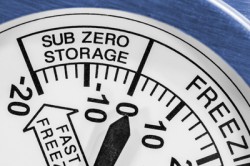We use cookies to make your experience better. To comply with the new e-Privacy directive, we need to ask for your consent to set the cookies. Learn more.
Choosing Better Lift Truck Battery Management Practices for Cold Storage Warehouses
For cold storage facilities, accurate planning is critical.
A difference of a few degrees can mean significant product losses, and a few inches of unused vertical space can translate to substantial operating inefficiencies.
This is why most cold storage operations perform extensive calculations when choosing material handling equipment and infrastructure -- a properly outfitted facility needs to maximize vertical space, match lift truck fleets with appropriate battery handling equipment, and manage safety while perfectly controlling temperatures. 
Temperature is an especially serious challenge for logistics managers when considering battery management practices. Many operations store different types of products at different temperatures; standard frozen foods might meet the Frozen Food Handling and Merchandising Alliance's recommendations of 0℉, but some products such as ice cream require lower temperatures of around -10℉. Non-frozen foods require temperatures ranging from 55℉ (vegetables) to 28℉ (most meats), and facilities that store multiple types of products -- or that stock seasonal foods -- every inch of the facility needs to be carefully planned. This certainly includes battery rooms and stations, which require some special attention in cold storage warehouses.
Among the most important considerations:
-
Condensation
- Condensation can build up on batteries and other components when lift trucks move to warmer environments. Over time, this can cause corrosion and premature wear that significantly limits the value of equipment. When lift trucks return to cold temperatures, the water can also freeze, causing immediate damage.
Mobile Battery Extractors can help to limit condensation by limiting the frequency of temperature changes. Otherwise, fleet managers can limit damage by instituting precautionary checks for condensation or by scheduling battery changes more effectively.
-
Battery Charger Room Location and Temperatures
- Sudden temperature changes can also affect battery life and charge times. For smaller or temporary battery stations, insulated curtain walls can help to isolate temperature zones, allowing for optimal charge times, and regular monitoring of battery and ambient temperatures can result in a much more effective workforce.
-
Fleet Management
- Many cold storage facilities cycle their lift truck batteries more frequently; proper fleet management is therefore more important. Software fleet tracking systems can take some of the guesswork out of logistics, reducing electrical consumption, lift truck downtime and other costs associated with change-outs.
-
Battery Checks and Maintenance
- Regular preventative maintenance also becomes more important with frequent temperature changes. Performance checks can reduce operating inefficiencies in cold weather environments while extending battery life cycles.
Cold storage facilities are becoming more common worldwide and throughout the United States; a 2014 report from Grand View Research, Inc. expects that the global frozen food market to balloon to more than $307 billion dollars by 2020. That's almost twice the segment's 2009 estimated worth of $165.4 billion, and it emphasizes the importance of better practices -- lift truck battery management is a crucial part of an efficient, safe operation.
